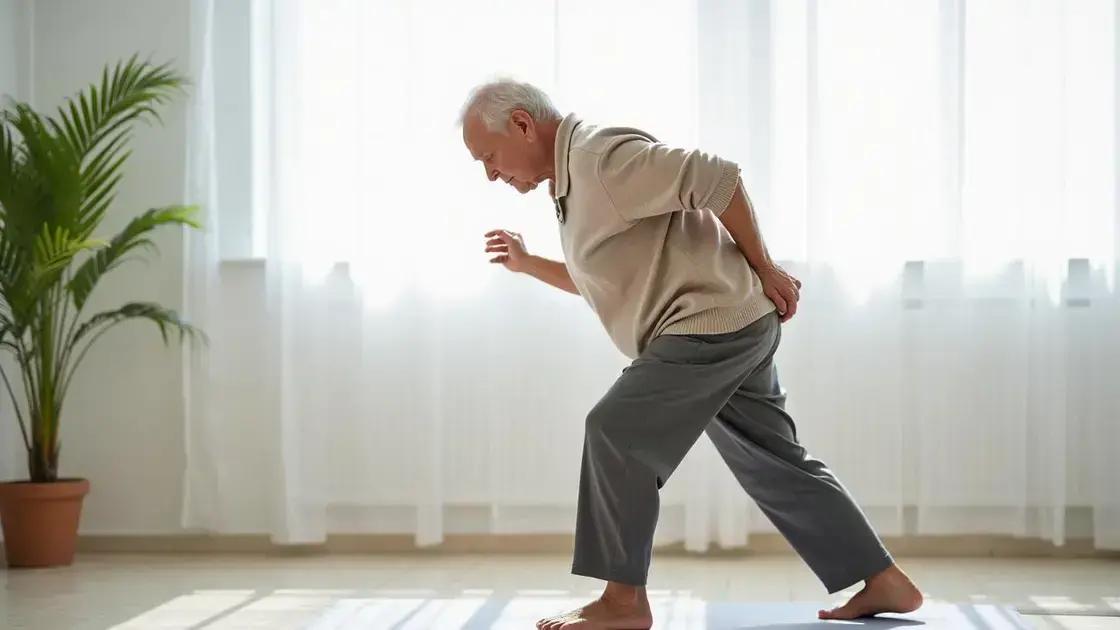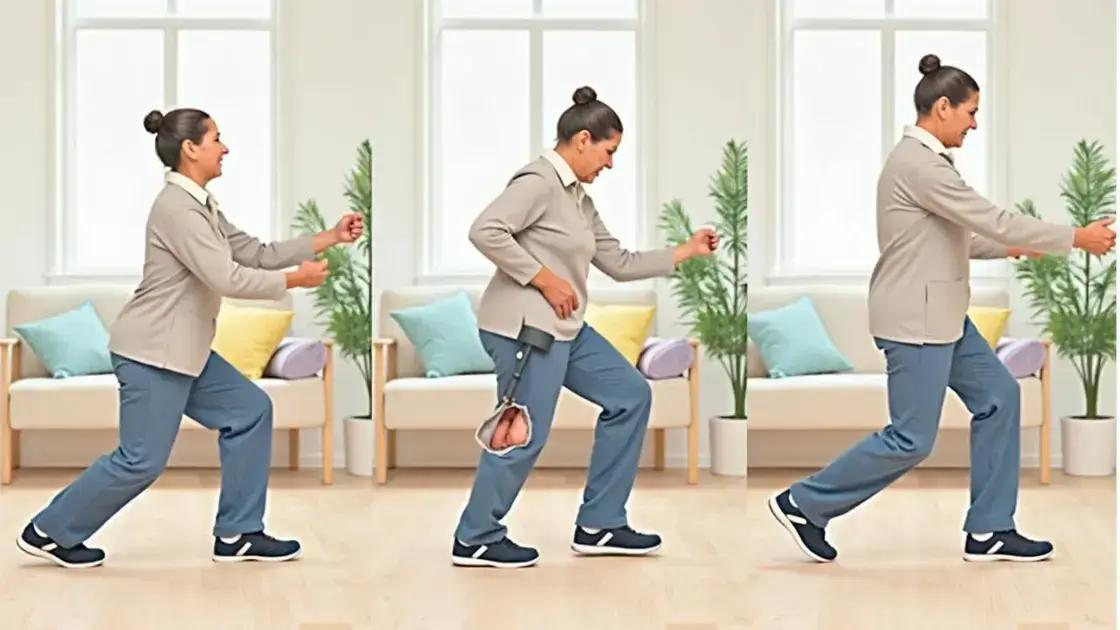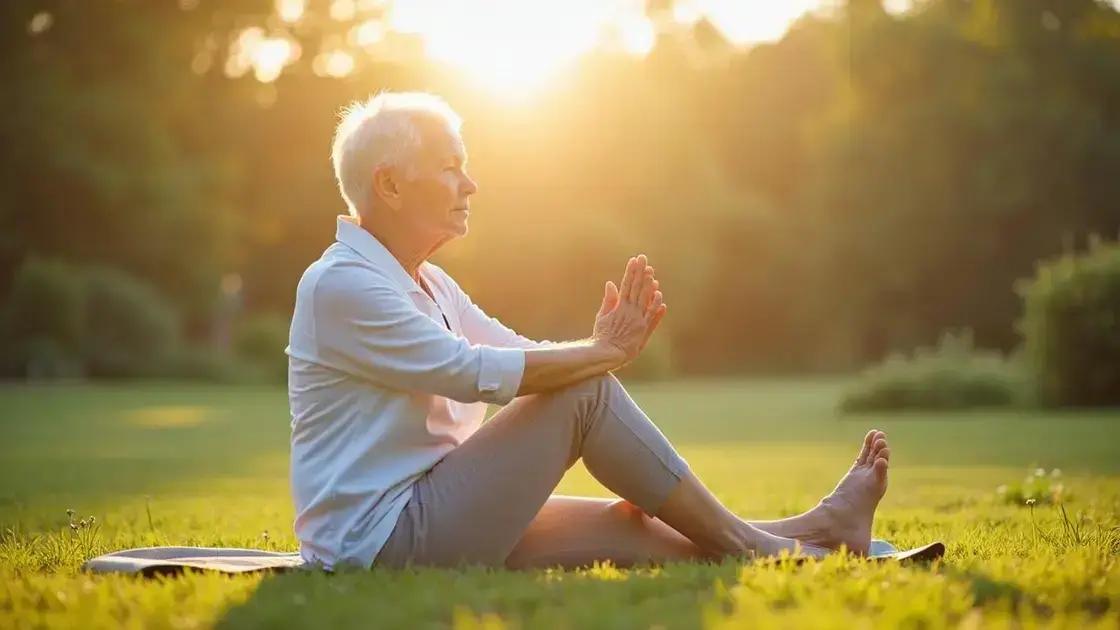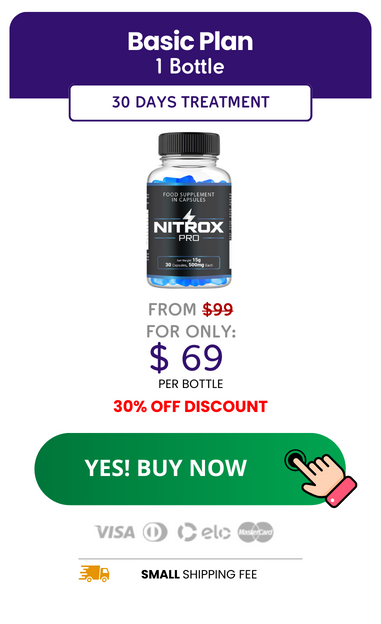Improving hip mobility after 50 involves understanding its importance, engaging in targeted exercises, and following practical tips to maintain flexibility, such as regular stretching, hydration, and incorporating activities like yoga or Pilates into your routine for better quality of life.
Improving hip mobility after 50 is essential for maintaining an active lifestyle. As we age, it’s natural for our joints and muscles to become more rigid, leading to decreased flexibility and movement. This article will guide you through understanding hip mobility, its importance, and practical exercises to enhance your flexibility, ensuring you can continue enjoying your favorite activities.
Understanding Hip Mobility

Understanding hip mobility is crucial for anyone, especially those over 50. It refers to the ability of your hips to move freely and with ease. As the largest joint in the body, good hip mobility plays a key role in everyday activities such as walking, sitting, and bending. Furthermore, hip mobility can influence posture and stability, reducing the risk of falls and injuries.
Components of Hip Mobility
Hip mobility involves several components, including flexibility, strength, and coordination. Flexibility allows the muscles and tendons around the hip to stretch and contract comfortably. Strength ensures that the muscles can support movements without strain, while coordination helps in executing smooth and controlled motions.
Common Causes of Reduced Hip Mobility
Many factors can lead to decreased hip mobility, particularly as we age. Sedentary lifestyles, poor posture, and lack of exercise contribute to stiffness. Over time, this stiffness can turn into pain or discomfort, making regular movements increasingly difficult. Being aware of these factors is the first step towards improving your hip mobility.
Assessing Your Hip Mobility
To ensure your hips are functioning correctly, perform simple assessments. One useful test is the hip hinge, where you stand with your feet hip-width apart and attempt to bend at the hips, keeping your back straight. If you struggle during this test, it’s a sign that you may need to work on your mobility.
Importance of Flexibility After 50

The importance of flexibility after 50 cannot be overstated. As we age, our muscles, tendons, and ligaments naturally lose their elasticity. This can lead to stiffness and discomfort, affecting our daily activities. Enhanced flexibility plays a crucial role in maintaining a quality lifestyle.
Improved Range of Motion
Flexibility is essential for achieving a full range of motion in your joints. When your muscles and connective tissues are flexible, you can move more freely. This increased range of motion allows you to perform everyday activities, like bending to tie your shoes or reaching for something on a high shelf, with ease.
Enhanced Physical Performance
Staying flexible can significantly improve your physical performance. Whether you enjoy gardening, walking, or dancing, flexibility is key. It allows for smoother movements, reducing strain and the risk of injury. This means you can enjoy your hobbies without limitations.
Reduced Risk of Injury
Increased flexibility directly contributes to a lower chance of injuries. When your muscles and joints are flexible, they can absorb shocks better and are less likely to become strained. This is particularly important for older adults, as a fall or injury can have severe consequences.
Better Posture
Flexibility also aids in maintaining proper posture. Good posture not only looks better but also alleviates unnecessary stress on your back and spine. With improved flexibility, you can sit or stand straighter, which can reduce discomfort throughout the day.
Exercises to Enhance Hip Mobility

Exercises to enhance hip mobility are vital for maintaining flexibility and strength as you age. These exercises can help you regain your range of motion, improve posture, and reduce discomfort. Below are some effective exercises that can be easily incorporated into your routine.
1. Hip Flexor Stretch
To perform a hip flexor stretch, kneel on one knee with the other foot in front. Gently push your hips forward while keeping your back straight. Hold for 20-30 seconds, then switch sides. This exercise stretches the hip flexors, helping to improve mobility.
2. Seated Forward Bend
For the seated forward bend, sit on the floor with your legs extended in front of you. Slowly lean forward, reaching toward your toes while keeping your back straight. Hold this position for 20-30 seconds. This stretch targets hamstrings and helps loosen tight hips.
3. Leg Swings
Stand beside a wall for balance. Swing one leg forward and backward in a controlled motion. Perform 10-15 swings per leg. This dynamic exercise can help improve hip joint mobility and strengthen surrounding muscles.
4. Figure Four Stretch
To do the figure four stretch, lie on your back with your knees bent. Cross one ankle over the opposite knee, then gently pull the uncrossed leg toward you. Hold for 20-30 seconds and switch sides. This stretch opens the hips and relieves tightness.
5. Squats
Squats are great for overall lower body strength and hip mobility. Stand with feet shoulder-width apart, and squat down as if sitting in a chair. Keep your back straight and ensure your knees do not go beyond your toes. Aim for 10-15 repetitions, adjusting your depth as necessary.
Tips for Maintaining Flexibility

Tips for maintaining flexibility are essential, especially for those over 50. Keeping your body flexible can enhance mobility, reduce discomfort, and improve overall quality of life. Here are some practical tips to help you stay flexible.
1. Regular Stretching
Incorporate stretching into your daily routine. Aim to stretch all major muscle groups at least 2-3 times a week. This consistent practice helps maintain and improve your flexibility over time.
2. Stay Hydrated
Drinking enough water is vital for muscle function and elasticity. Aim for 8-10 glasses of water a day, or more if you’re active. Proper hydration supports overall health and allows your muscles to stretch more easily.
3. Warm-Up Before Exercise
Always warm up before any physical activity. Warming up increases blood flow to your muscles and helps reduce the risk of injury. Spend 5-10 minutes doing light aerobic exercises followed by dynamic stretches.
4. Use Foam Rollers
Foam rolling can help release tension in tight muscles and increase blood flow. Spending a few minutes on a foam roller can improve your flexibility and aid recovery post-exercise.
5. Listen to Your Body
Pay attention to how your body feels during movement. If you experience pain or discomfort, stop and assess. It’s important to differentiate between stretching discomfort and pain, as pushing through pain can lead to injury.
6. Incorporate Yoga or Pilates
Practicing yoga or Pilates regularly can significantly improve flexibility. Both activities focus on stretching and strengthening muscles while enhancing body awareness and balance.
In Summary: Embrace Flexibility After 50
Improving hip mobility and maintaining flexibility after 50 is essential for a healthier and more active lifestyle. By understanding the importance of flexibility, engaging in targeted exercises, and following practical tips, you can enhance your mobility and overall well-being.
Incorporating regular stretching, staying hydrated, and practicing mindfulness through yoga or Pilates are effective ways to keep your body agile. Remember, listening to your body and being consistent with your efforts are key to achieving long-term results.
Embrace these strategies, and enjoy the freedom of movement as you age gracefully.
FAQ – Frequently Asked Questions About Hip Mobility After 50
Why is hip mobility important after 50?
Hip mobility is crucial for maintaining an active lifestyle, improving balance, and preventing falls as we age.
What exercises can help improve hip mobility?
Exercises such as hip flexor stretches, seated forward bends, leg swings, figure four stretches, and squats are effective for enhancing hip mobility.
How often should I stretch to maintain flexibility?
Aim to stretch all major muscle groups at least 2-3 times a week to maintain and improve your flexibility.
What should I do if I feel pain while stretching?
If you feel pain while stretching, stop immediately. It’s important to differentiate between stretching discomfort and pain to avoid injury.
Can yoga or Pilates help with flexibility?
Yes, both yoga and Pilates focus on stretching and strengthening muscles, greatly enhancing flexibility.
What are some tips for staying flexible as I age?
Stay hydrated, warm up before exercises, incorporate foam rolling, and listen to your body to maintain flexibility.













